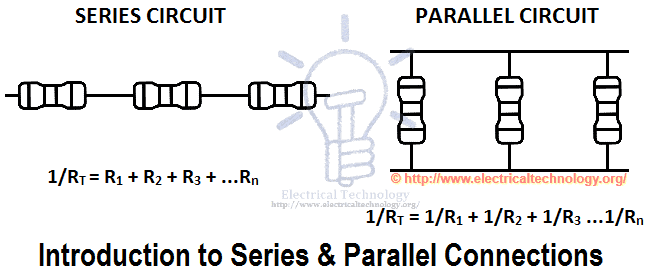Introduction to Series & Parallel Connections
The use, application and importance of series and parallel circuit connection today cannot be over emphasized. The application of series and parallel circuit connection can be evidently seen in our homes, school halls and in our street lights. With the press of a button, all the Bobs in our sitting rooms are turned on. some refer that the bobs in their homes should have different switches.

Well, it’s not a magic when more than three electric bobs or loads are controlled by one switch. A load is anything i.e. it could be an appliances, electric bobs or even ceiling fans that consumes electrical energy when connected to a power supply. The electric bobs, televisions, refrigerators etc can all be referred to as a load. The bobs convert electrical energy into light and heat form of energy. Fans convert the electrical energy into mechanical energy.
The type of connection done to our ceiling fans, electric bobs will determine if they will have a common switch or not. Series circuit connection gives us the opportunity to connect more than two loads to a common switch. Street lights are a very good example of this. Parallel circuit connection makes it possible for us to connect loads to their individual switch. Both series and parallel circuit connection are good but one is mostly preferred over the other for one reason or the other. Before we talk about the reason why parallel circuit connection is preferred over series connection, let’s recall what series and parallel connections are first.
SERIES CIRCUIT
A series circuit is a circuit in which resistors or loads are connected end to end so that the circuit will have only one path through which electric current flows. Thus, when a number of resistors are connected in series, the effective resistance (total resistance in the circuit) is gotten by adding the individual resistance algebraically. That is to say, if we have resistors with resistance R1, R2, R3 …Rn connected in series, then;
Reff = RT = R1 + R2 + R3 + …Rn.
In series connections, the same current flows across all the branches of the circuits, but different voltage across it thus making the resistors to have different voltage across them. Each resistor or load will experience a voltage drop. The applied voltage is equal to the sum of the voltage drop across the different parts of the circuit. Voltage drop is proportional to the resistance current being the same throughout the circuit. When loads are connected in series, the loads will tend to have a common switch. This kind of connection is employed in school halls, street lights.
Uses & Application of Series Connection
Some people connect security lights in their homes in series which will make them to have common switch. The problem with this kind of connection is that when a load develops a problem, the other connected system will fail. It’s an all or none type of circuit connection. Till a load gets energy before it delivers it to the other and the one to deliver fails, there will be a black out.
Series circuit connections are common and greatly employed in electrical equipments. The tube filaments in small radios are usually in series. Current controlling devices are always connected in series with the device that they protect. Fuses are connected in series with the device they protect, Automatic house-heating equipment has a thermostat, electromagnetic coils, and safety cut-outs connected in series with avoltage source etc.
PARALLEL CIRCUIT
Resistors, loads are said to be connected in parallel when the end of each of the resistors or loads have a common point or junction and the other ends are also connected to a common point or junction. Such circuits are known as parallel circuits.
Unlike the series circuit connection, when finding the total (effective) resistance in a parallel circuit, the reciprocal of the individual resistance is taken. Thus, when a number of resistances are connected in parallel, the reciprocal of the effective resistance is given by the arithmetic or algebraic sum of the reciprocal of the individual resistance.
1/Reff or 1/RT = 1/R1 + 1/R2 + 1/R3 …1/Rn.
Parallel circuit connection have the same voltage flowing across all the branches of the circuits. Different resistors have their individual currents.
Uses & Application of Parallel Connection
Parallel circuit connection is very common in use. Various lamps and electrical appliances in our homes are connected in parallel so that each of the lamps or bobs and appliances can be operated independently. For us to have control over the individual lamps or loads, they have to be wired in parallel.
ADVANTAGE OF PARALLEL CIRCUIT CONNECTION OVER SERIES CIRCUIT CONNECTION.
A series circuit connection is an all or none type of circuit connection. Meaning that if one of the appliances fails, all the other appliances will also fail which is why this type of connection is good only when we want to protect a device.

When a fuse gets burnt for instance due to high current, then the appliance it protects will not be damaged because current will no longer reach it. While series connection is an all or none, parallel circuit connection gives you the opportunity to give the loads and the appliances their individual switch. Parallel connection offers resistance to the flow of current compared to series connection.
A 100 ohms and a 150 ohms resistors connected in parallel will have less effect on electric current compared to 50 ohms and 40 ohms resistors connected in series. In electronic devices, parallel connection is paramount. The cells in a power bank are all connected in parallel. Parallel connection makes electrical energy to last longer. The cells themselves have their internal resistance, so if they were connected in series, some of the energy will be lost overcoming the internal resistance since it’s effect is high when in series than when in parallel.


